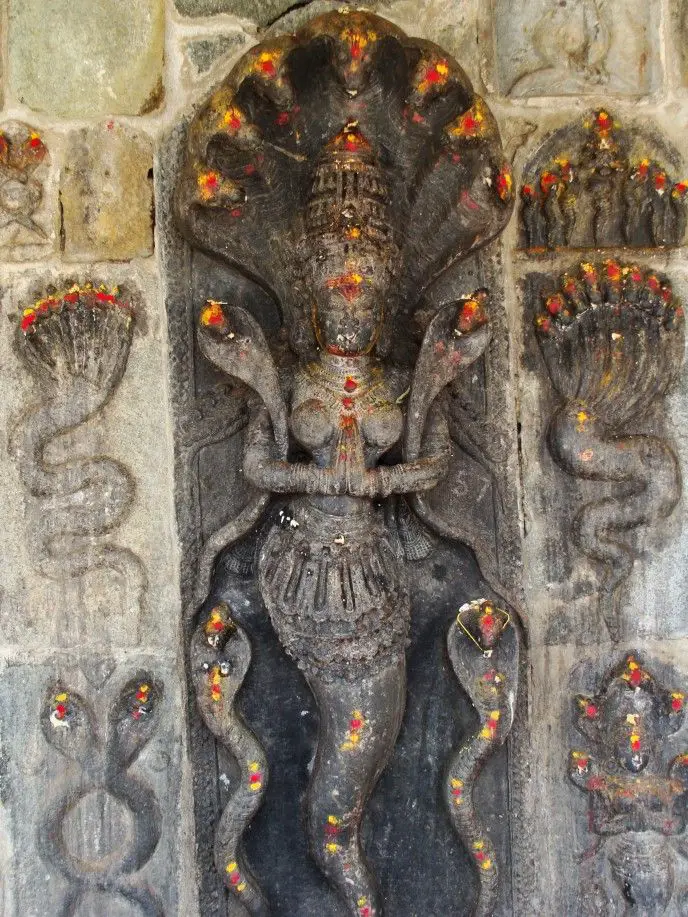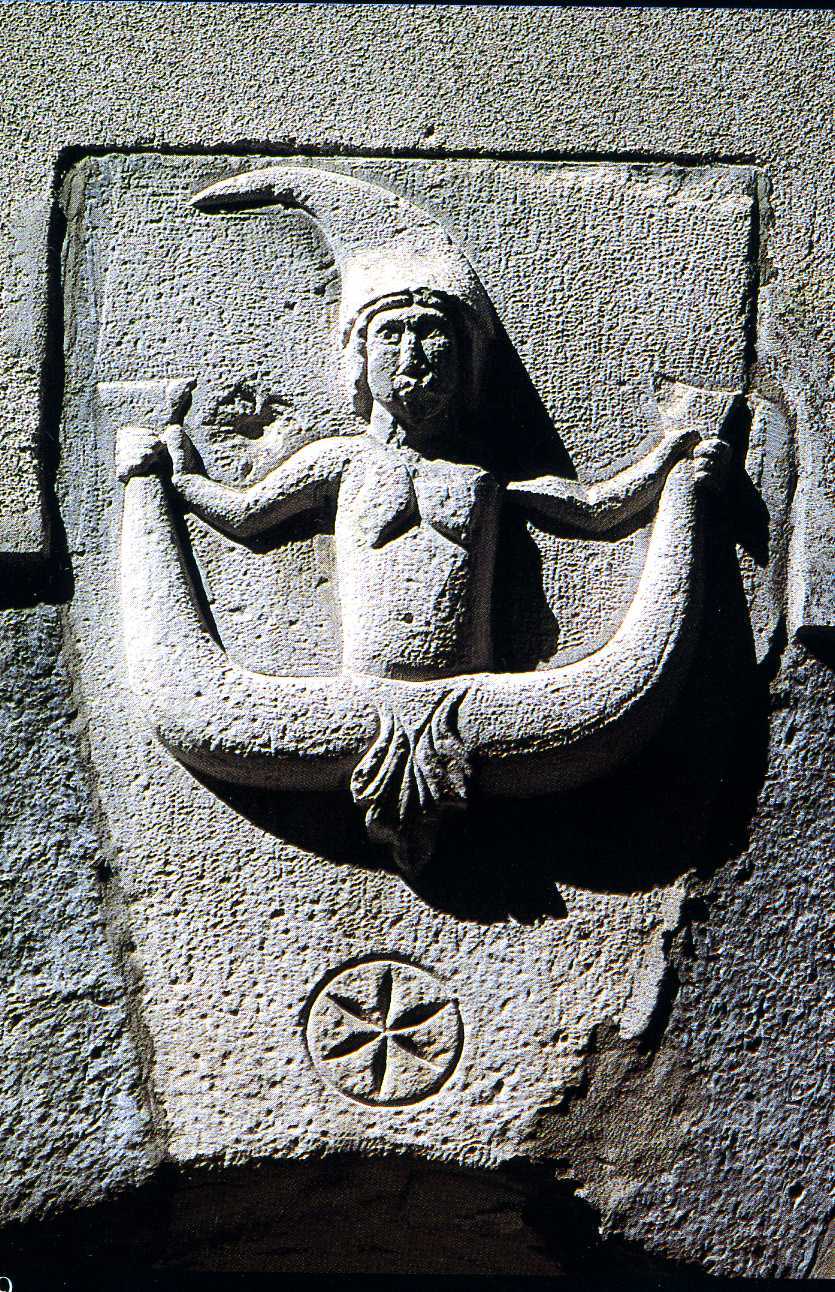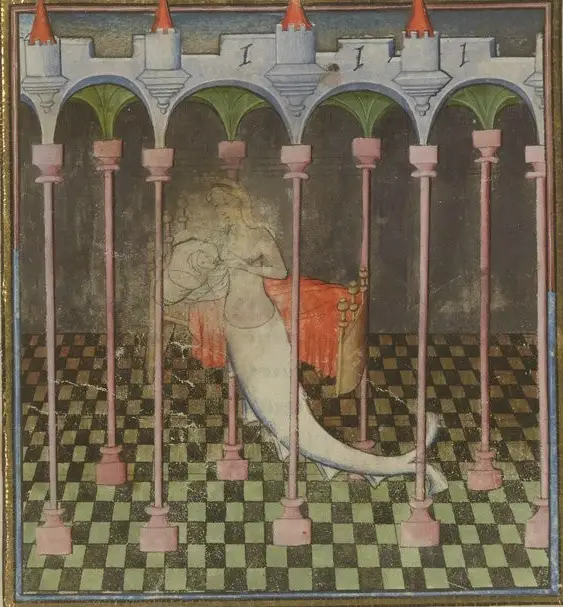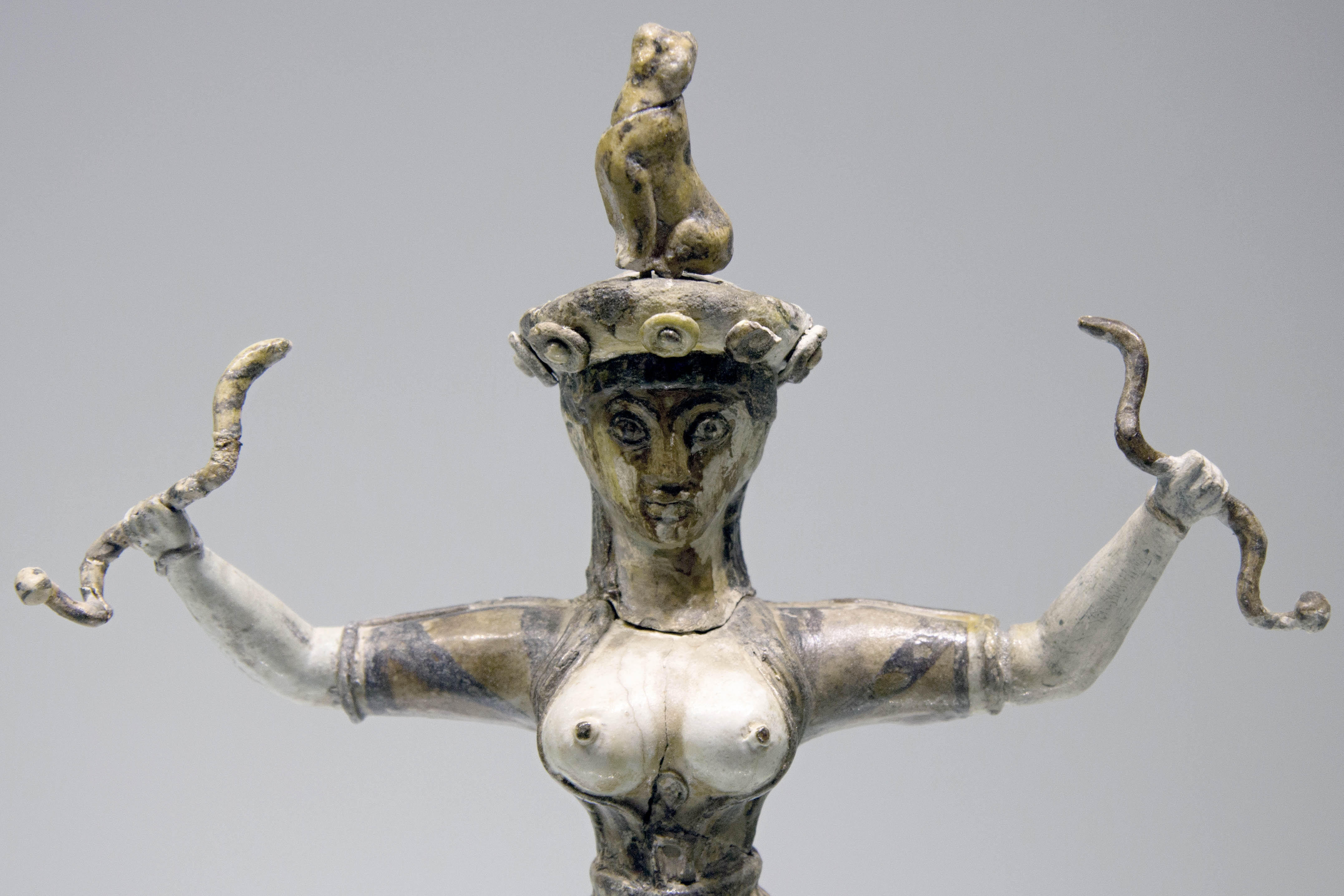Mythical ancestors, cultural heroes, feral entities of the subtle world and supernatural brides: the topos of the ophidic-anthropomorphic mythical entities is widespread throughout the world, and affects both the European tradition (regarding which we will focus above all on the medieval tradition of the Fairy Melusina ), as well as extra-European traditions such as the Indian one of the Nagas, "serpent people" residing in the world below ours, that of the Hopi and that of the Australian aborigines.
di Marco Maculotti
adapted from "The snake and the dragon: morphology of ophidic symbolism ", ne The Age of the Serpent, Valusia # 2, Italian Sword & Sorcery Books, Summer 2019
cover: ophidic-anthropomorphic mythical entities of the Chinese tradition
Often the archetypal figure of the snake and the dragon is connected to the rainbow and to particular atmospheric phenomena: very ancient beliefs that date back to the mists of prehistoric times depict the rainbow as a snake-worm-dragon that sucks water from the sea and rivers, thus causing rainfall. These are beliefs that have survived in historical periods even in Europe (Italy, France, Albania, Romania, etc.), as well as throughout Central Asia. Gian Luigi Beccaria writes [1]:
«The assimilation of the rainbow to the snake that emerged from the underworld is widespread in East Asia: in ancient China it was represented as a two-headed snake; in the myths of the ancient island of Java one head of the serpent absorbs water from the North Seas and the other pours it into the South Seas. In the tribes of northwestern Australia the rainbow-snake is a cultural hero, the most important mythological figure. The name of the rainbow is explicit in Belarus, serpente. The Indo-Europeans of the East had attributed atmospheric precipitation to the conflict between the god of lightning and the serpent god of waters. And this idea of the celestial serpent is also present in the African and American languages. […] Among many tribes in Africa and Oceania the lordship of the underground waters falls to the rain serpent, sometimes identified with the rainbow. At the Nagos of the African coast, the rainbow was the huge snake that lives at the bottom of the ocean where it fills with water; his name in Dahomey (present day Benin) is celestial serpent, in northern Guinea Northern snake. […] Even in France, on the northern coasts, the belief was widespread that the rainbow was a snake that comes to quench its thirst on earth. The rainbow-snake association emerges everywhere, the image of a beast, of a monster that devours, sucks, swallows. "

Ungud, the Rainbow Serpent, and the Wondjina
One of the most important mythical figures in this regard is Ungud, the Rainbow Serpent, creator god in the tradition of the Australian Aboriginal Ungarinyin [2]. In their creation myth, Ungud sent fresh water from heaven and created the first ancestral copy in the waters; then he sent to his earth his son Wálangala, at the same time a celestial deity and a cultural hero, who conferred on humanity all social and cultural institutions, in particular the initiation rites. Ungud, supernal god, after creation, "at the end of primordial time", ascended to heaven; and likewise made him his son Wálangala, who is also said to have a human figure as long as he was on earth, but turned into a serpent when he returned to heaven. On the other hand, many Wondjina (divine figures of the Australian tradition) take on an ophidic aspect at the end of Creation, without however losing their anthropomorphic qualities.
Other myths of the Australian tradition hand down that the Wondjina, at the end of the "Dream Time" (Dreamtime), have also penetrated the earth, and thus become "emanations" of the Rainbow Serpent Ungud in its "underworld" aspect, this by bringing to mind what we have said about the double aspect of the Cosmic Serpent and also anticipating what we will have to say about the Indian beliefs about the Nāga. The Wondjina in fact, similarly to the Nāga and the ophidic entities of the Pueblo tradition, appear associated with rain, children's spirits and fertility.

It is supernatural beings dwelling in caves, possessing "the power to give life, power linked to water"; their very name can be translated as "near water", or "belonging to water". They came found in illo tempore from Ungud "in a" creative dream "at the bottom of the water" [3]: for this they are considered tutelary geniuses of rivers, lakes e wells. From them, and through their intercession directly from the Rainbow Serpent Ungud, the Australian medicine men derive their powers: only they can see and speak with the Wondjina and with Ungud. In their sacral conception, the aborigines warn a perfect continuity between Ungud's Creation work, that of his 'sons' Wondjina, and that of the individuals (medicine men and magical operators) who, even today, keep the world alive.
The Wondjina, in fact, are also considered the cultural heroes and legislators who were generated by Ungud to continue the Creation after his retreat into the skies. Immediately after they came to life, they traveled the earth far and wide, bringing rain and changing the landscape, creating the hills and plains and giving a name to everything that exists in nature. It is also said that, "when the stones were still wet" the Wondjina built large "stone houses", a mythical memory in which Eliade recognizes a clear clue concerning a megalithic tradition. For our part, we note how this mythologem closely resembles the Andean one of Viracocha and of his Creation first by his own hand, then by means of his 'emanations' [4]; and it is perhaps no coincidence that the constant reference in the Peruvian mythical tradition to thesnake emblem on the headdress of the Viracochas cultural heroes, just as it is interesting that the most relevant dynasties of ancient Central America - including Toltecs, Olmecs, Teotihuacani, Aztecs and Maya - called themselves "Serpent peoples"; nor is it perhaps a coincidence that it was precisely these lineages that brought, in the Americas as in oceania and in Pacifico, megalithic culture, as well as sacred institutions and rituals.

The "serpent people" and the Nagas
The same beliefs and rituals are found, as anticipated, also in North America, among the Hopi Indians, of which «snake people» we have already mentioned at the beginning, and more generally in all the Pueblo tribes. The rituals related to the figure of the snake of these peoples have been studied by Aby Warburg in his famous work entitled The Serpent Ritual [5]. Also from this study emerges above all the symbolic role attributed to the latter as bearers of the rains, And then guarantors of the fertility of the fields for the coming season: the Hopi pray to them, among other things, for rain and melting snow to irrigate their crops. And nevertheless, even among the Pueblos, exactly as in the Australian tradition, such rituals appear connected to the veneration of supernatural entities, i Kachina, who in illo tempore they have given humanity its rites and institutions and have participated in the Creation of humanity and the sacred territory on which they live - even if in the Hopi tradition they seem to dwell in the heavens and the winds, thus distinguishing themselves from the serpent-people of the myth we have referred to above, which claims to be located in a underground dimension.
To the 'underground' aspect ofserpentine archetype which we have already mentioned are linked to ancient traditions about partly serpentine entities residing in the subsoil, or rather in worlds below ours. The most famous example, of course, is found in Nāga of the Hindu tradition, "Serpent people" of mythical epics, semi-divine hybrid race yet with demonic characteristics, which dwells both in the "Underground world of snakes" (Nagaloka) than on earth, in caves located within inaccessible mountains and underground. According to Alain Danielou [6], "The legend of the Nāga seems to have originated from multiple sources which were then mixed and merged: on the one hand, the cult of snakes considered tutelary geniuses of trees and rivers; on the other, the memory of ancient non-Aryan clans who worshiped snakes. Today the Nāga are still revered in most villages of theSouthern India. The snake was perhaps the totem of the ancient Dravidians and, until recently, in the east and south of India there were dynasties of sovereigns who were depicted with the emblem of a cobra head on the crown.

Nineteenth-century anthropologists had no doubts in connecting the Nāga (or at least their cult) to people who dwelt in the hills of north-eastern India, dark and short, which, following the Indo-European invasion from the north, moved further south. It is believed that their cultic system provided, as mentioned, the cult of the serpent with annexes human sacrifices [7]. Probably also for these demonic characteristics, the people of the Nāga are considered in the Indo-Arian cosmogony to be related to a whole series of feral entities of an evil and demonic character, like Yakshas and Yakshini, Guhyakas, Rakshashi, and so on; all categories of beings residing in other worlds, and precisely in the Pātāla, that is to say the "lower worlds" (mind you, in a non-literally physical-geographical meaning) of the Hindu tradition. Either way, it will be easy for the reader to notice as well as in the East la suppression of the cult ophidic is to be historically related to the Indo-European invasions, exactly what we have seen also emerge from the myth of the god's conquest of the Dauphin Apollo.
In addition, it is interesting to note how it was born from the residual substratum of these ancient populations a medical science making use of snake venom as a medicine; the doctors of this sect were able to handle any type of poisonous snake without any problem, the serum of which, moreover, is not harmful to them in any way. The connection with the cult of Asclepius in the West and with the folkloric tradition, still in vogue today, of the Serpari of Cocullo, in Abruzzo, it is evident. Here we come across the esoteric maxim that looks to poison as a potential drug, for those who knew how to 'handle' it correctly: the poison is presented in this order of ideas as a materialization ofthe energy shaktic-kundalinic of which yogi you must master to receive the gift of healing.
Inevitably, as the reader can see, the interpretative plans of our discourse are continually unraveling and reconnecting, as is obvious when the network of mythical correspondences is analyzed from a traditional and all-encompassing point of view.

The Fairy Melusina and the dominion over "groundwater"
In the European tradition, this topos it has remained in vogue through the centuries, even following Christianization, in the Middle Ages and beyond. The credit must paradoxically be given to secularization or 'profanization' of the sacred tradition previously in vogue: the myth is transformed into folklore, folklore into a fairy tale. The degradation of the sacral character of this ancient knowledge is visible to all, but at the same time we can say this only because the structural elements that constituted the foundations of the myth can now be found in the 'lower' culture, that is to say precisely in the beliefs folklore and fairy tales.
In this regard, the most paradigmatic example is that of Fairy Melusina, an anguiped female entity that has many points in common with the classical nymphs (they dwell near fountains or gods loci amoeni connected to the sacredness of the water element), with sirens and with ancient celtic mother goddesses, givers of fecundity, fertility and abundance: the fairy Melusina, in the various versions of the story, brings good luck and wealth to the man who takes her in marriage and for whom, in addition to conceiving children, he builds castles and monasteries, reclaims swamps, and so on. It was believed that this kind of feral entity could conquer a soul similar to that of men only by marrying one of them; nevertheless, to the marriage bond they placed a taboo: on a certain day of the week, the groom was highly forbidden to see them. That was in fact the day in which they underwent a metamorphosis that revealed their real appearance: that of women with the lower extremity of the serpentine body or ichthyoforms.

In all medieval tales, Melusina's groom on duty (usually knights of high lineage, such as that of the Lusignans, who boast their descent from the Fairy) end up being seized by an ungovernable curiosity and therefore to see their bride naked, intent on taking a bath (the aquatic element returns again), the taboo day, usually Saturday. The violation of the prohibition punctually results in the knight's ruin, the fall into madness, sometimes death: this is because the fairy was considered, in accordance with the Latin etymology (from fate, "Fate, sorte") the giver of fortune and knightly authority, similarly to what we said above regarding the double symbolism of the 'princess' and the 'dragon' that the hero must respectively save and defeat: it is, once again, the double aspect of his soul, which he must at the same time dominate and sublimate.
In corpus legendary of Melusina there are numerous typical mythologues, some of which are obviously closely related to the ophidic symbolism: the metamorphic nature of the fairy, similarly to that of the reptile, is at the same time a harbinger of attraction and repulsion, sensuality and disgust, life (the numerous children who in the various versions of the legend gives birth to the groom) e death (often after the breach of the taboo by the groom, the fairy disappears with the progeny or even kills them).
In this sense the serpentine nature of Melusina is to be connected to renewing faculty that recognizes itself in the land itself and in the "underground waters", of which the fairy, like the aforementioned nymphs, sirens and undines, appears to be an epiphany charged with meaning. Melusin it initially emerges from a spring and is always caught by the groom in the act of taking a bath; in the Sicilian version of the legend that reached us thanks to Goffredo d'Auxerre it comes from the sea and disappears in its waves. In other folkloric tales there is talk of the marriage of a noble to one "Woman of the Lake", belonging to a group of feral entities that can be glimpsed on the shore of a lake and then disappear under the waves: sometimes, in the legends of Wales and the Isle of Man, these girls appear in the zoomorphic form of seals, and the pretender to their hand obtains it by stealing their animal skin momentarily abandoned on the shore.

By connecting to the «water snake», a mythical entity at the same time terrifying and beneficial (like the pharmakon / poison above), bearer of fertility and guardian of the Other World under ours, Melusina returns at night, also following the bridegroom's sin, to breastfeed and take care of her children in secret. But Melusina is also a functional copy of the banshee Irish, appearing whenever a member of the Lusignanian family is about to die, to announce the sad event. In this sense, Melusina's serpentine nature is also a sign of hers selene-chthonic power, of his dominion over the earth and over the telluric and lunar cycles of life-death and rebirth.
In this regard it is significant, to conclude our short essay on ophidic symbolism in the history of religions, that Carlos Ginzburg, following back in the footsteps of witches' "nocturnal history" through the millennia, he finally came across "a goddess half woman half snake, surrounded by pairs of snakes" [8], identical to the Minoan-Cretan "Goddess of Snakes" mentioned in the opening and to the "Lady of the Animals" of Scythians of the Eurasian steppes. Those who follow our research will know that precisely from that geographical area, following the indications of Ginzburg himself and other scholars, we believe that those arboreal and shamanic cults, connected at least in part to one 'matriarchal' sacral-social vision (to be related with the epochs aphroditic e demetric of which Bachofen speaks) and to the observation of lunar cycles; cults, linked to the symbolism of the snake and the domination of underground and supernal waters which, to conclude with a 'circular closure', were gradually relegated to the 'underground' current of history and culture, first of all by the Indo-European invasions and, above all, , from the spread of Christianity then.

Note:
[1] GL Beccaria, The names of the world. Saints, demons, goblins and the lost word, Einaudi, Turin 1995, pp. 73-74
[2] M. Eliade, The creativity of the spirit. An introduction to Australian religions, Jaca Book, Milan 1978
[3] Ibid, p. 69
[4] See M. Maculotti, Viracocha and the myths of the origins: creation of the world, anthropogenesis, foundation myths, on AXIS mundi
[5] A. Warburg, The Serpent Ritual, Adelphi, Milan 1998
[6] A. Danielou, Myths and gods of India, BUR (Rizzoli Universal Library), Milan 2002, p. 352
[7] A. Morretta, The gods of India, Longanesi, Milan 1966, pp. 255 and following
[8] C. Ginzburg, Night story. A decipherment of the Sabbath, Einaudi, Turin 1989, p. 191

2 comments on “Ophidic folklore: the "Rainbow Serpent", the Nagas and the fairy Melusina"